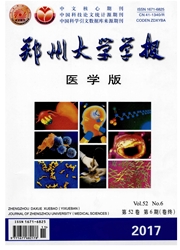

 中文摘要:
中文摘要:
目的:应用人工神经网络技术,联合肿瘤标志蛋白芯片对肺癌及肺良性疾病进行诊断,建立肿瘤标志蛋白芯片联合人工智能的辅助诊断模型。方法:收集有肿瘤标志蛋白芯片检测记录的肺癌和肺良性疾病患者共102例,其中肺癌50例,肺良性疾病52例。利用人工神经网络技术,对9项指标进行联合检测,建立基于人工神经网络的肿瘤标志蛋白芯片智能诊断模型。结果:人工神经网络模型、判别分析和蛋白芯片检测系统对肺良性疾病和肺癌识别的准确度分别为88.0%、64.0%和60.0%,人工神经网络模型的ROC曲线下面积0.878,准确度较好,而判别分析模型的ROC曲线下面积(0.635)和肿瘤标志联合检测的ROC曲线下面积(0.596)均〈0.7,准确度较差。结论:人工神经网络联合多肿瘤标志蛋白芯片检测系统建立的模型可以很好地区分肺癌和肺良性疾病,对肺癌的诊断和鉴别诊断效果优于判别分析和蛋白芯片检测系统。
 英文摘要:
英文摘要:
Aim:To establish two classification models of artificial neural networks(ANN) and Fisher discrimination analysis,and to compare the differences among two models and the multiple tumor marker protein biochip detective system in the diagnosis of lung cancer.Methods:The clinical data and multiple tumor marker protein biochip detective system records of 102 lung disease patients(50 cases of lung cancer and 52 cases of benign pulmonary diseases) were retrospectively reviewed,and then the models of ANN and Fisher discrimination analysis were developed.Results:The accuracy of ANN,Fisher discrimination analysis and multiple tumor marker protein biochip detective system was 88.0%,64.0% and 60.0%.The area under ROC curve of ANN(0.878) was higher than that of Fisher discrimination analysis(0.635) and multiple tumor marker protein biochip detective system(0.596).Conclusion:The effects of ANN model established by multiple tumor marker protein biochip detective system are better than those of Fisher discrimination analysis and multiple tumor marker protein biochip detective system in discrimination of lung cancer.
 同期刊论文项目
同期刊论文项目
 同项目期刊论文
同项目期刊论文
 期刊信息
期刊信息
